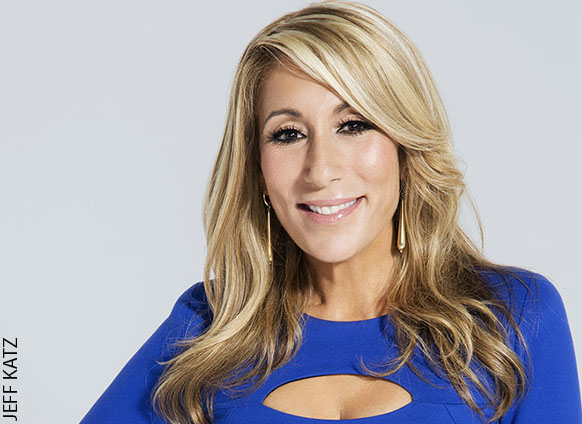
Shark Tank Appearance: Nov. 6, 2015
Investor: Lori Greiner
Deal: $125,000 for a 20 percent stake
Results: In seven months, sales increased from $575,000 to $9 million. More than 1 million Simply Fit Boards were shipped to retail stores for the fourth quarter of 2016.
Sometimes it takes a fair amount of digging to know whether a product is, in the lingo of Shark Tank investor Lori Greiner, a “hero or a zero.” Other times the recognition is immediate. The latter was the case in late 2015 when Gloria Hoffman and her mother Linda Clark walked onto the set of the Emmy-winning ABC reality show toting brightly colored plastic ovals that looked like the kind of platter you might use to serve chicken wings and Mai Tais at a retro tiki-themed cocktail party.
What Hoffman and Clark were actually hawking was the Simply Fit Board, their DayGlo take on the traditional balance board for core exercise. While Mark Cuban, Robert Herjavec and Kevin O’Leary joined the entrepreneurs in twisting on the core-chiseling devices, Greiner and Barbara Corcoran demurred because they were wearing high heels. For her part, Greiner didn’t need to break a sweat to know she wanted to make an offer. “Sometimes the simplest things are the best products,” Greiner says. “This one just works. I saw them twisting on the board, and I was ready to do a deal right away. I’ve been in the TV world a long time, and I knew this would be a fabulous infomercial product.”
Three things about the Simply Fit Board led Greiner, “the Queen of QVC,” to the conclusion that the product would succeed:
- It had the right price point. Over 18 months, Clark and Hoffman had sold nearly 16,000 boards, primarily at consumer shows, for $45 each.
- It had universal appeal. “Anybody can use the board,” says Greiner “and everybody on earth has belly fat they want to get rid of.”
- It’s very visual. “When you see people using the board you get it right away, and that makes for a great infomercial.”
An added plus was that Hoffman and Clark themselves were camera-ready. Representing two different generations, they were passionate, vivacious and photogenic. “I could just tell that they would be good partners for me,” Greiner says. “That was key. You can have the greatest product in the world, but if you don’t have good partners, you’re sunk.”
Related: 10 Questions to Ask Yourself for a Successful Collaboration
There was, however, one liability: Simply Fit didn’t have a patent and its strongest selling point—its simplicity—meant that it could easily be replicated. “We needed to be everywhere very fast and blitz the market,” Greiner says. “My goal was to create an infomercial instantly and get Simply Fit out there so it would become so big, there’d be less incentive to copy us.”
In the first 24 hours they sold 34,000 units; in 48 hours they’d racked up $1.7 million in sales.
The day after the Shark Tank episode ran, there was an airing for Simply Fit on QVC, featuring Clark. In the first 24 hours they sold 34,000 units; in 48 hours they’d racked up $1.7 million in sales. They sold out the line in less than three days, when they had to stop taking online orders. Six weeks later, when they resumed taking orders, they had a waiting list of more than 52,000 orders.
That backlog aside, it has been a mostly bump-free ride. “Honestly, there are usually ups and downs and struggles, but we really haven’t had any,” Greiner says. “This is a once-in-a-lifetime kind of product. We just launched in every Home Depot, Wal-Mart, Bed Bath & Beyond and Kmart store, and soon we’ll be all over Europe, Japan and Australia. It’s just an amazing Cinderella story.”
For Hoffman and Clark, this is the fairytale ending they’d been counting on. The two had stood in line at any open call for Shark Tank in Colorado, their home state. “We always knew that if we got in front of the producers they’d be sold,” says Clark, who, some 25 years ago launched Play Clay, a scented, organic play dough that’s still being sold today. Hoffman, a mom of two young sons and a former real estate agent, certainly hoped that mother knew best. She was down to $52 in her checking account before their Shark Tank appearance. “When you’re a small-business owner, every cent goes back into the business,” she says. “We were just doing whatever we could to make the American dream come true.”
Today, with the infomercial company taking over manufacturing and fulfillment, Hoffman and Clark are free to concentrate on marketing efforts and enjoying their success. They have both purchased new homes, and last year Hoffman took her boys on vacation to a resort in the Dominican Republic. “We don’t live extravagant lifestyles by any means,” Hoffman says. “For me success is being able to spend quality time with my boys without the stresses of money worries. I hope my mom and I can inspire other entrepreneurs that with a good idea and lots of hard work, your dreams can come true.”
Related: 5 Simple Steps to Plan Your Dream Life
This article originally appeared in the February 2017 issue of SUCCESS magazine.




